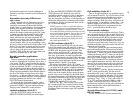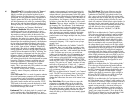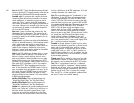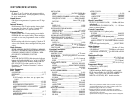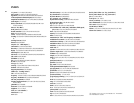DX SYNTHESIZER GLOSSARY
ADSR This is an acronym for "Attack-Decay-Sustain-Release"
which, in turn, refers to the four controls provided on a con-
ventional synthesizer's envelope generators. While the DX
synlhesizers can simulate ADSR-type EGs, the DX EGs are
more complex. ADSR EGs have 4 variables, whereas DX EGs
have 8 variables.
After Touch The DX7 keyboard has pressure transduc-
ers beneath the keys that permit the player to alter the
sound based on how hard the key is pressed after it
"bottoms out." This aspect of touch sensitivity is known
as After Touch. It may be used to apply LFO modulation
to the pitch or amplitude, or to alter the envelope gener-
ator bias, depending on the way the DX7 FUNCTION
mode is programmed, and depending on the pro-
grammed values within the particular voice.
Algorithm An algorithm is an arrangement of opera-
tors. It is roughly the equivalent of a "patch" in an older
style, modular synthesizer. The DX7 has 32 different
algorithms.
AMD This is an abbreviation for "Amplitude Modulation
Depth." Increasing the AMD value applies more LFO
modulation to the operators, which causes their output
levels to go up and down according to the set LFO
speed and waveform. AMD will have an effect only if
the Amplitude Modulation Sensitivity is set higher than
0 for individual operators.
Amplitude This refers to the output level of an opera-
tor. Amplitude may or may not be related to "volume,"
depending on whether the operator whose amplitude is
being varied is a modulator or a carrier. When the
amplitude of a carrier is changed, the "volume" or out-
put level of the synthesizer changes. When the modula-
tor amplitude is varied, the timbre of the voice changes,
and, subjectively, the volume may also change (loudness
depends on timbre as well as level).
Attack This is the beginning of a sound or the initial
transient of a musical note. In the DX synthesizer enve-
lopes, L1 generally determines the maximum level of
the attack, while Rl determines how rapidly the note
reaches L1. Rl can thus be considered the attack rate. In
a conventional synthesizer, there is no attack level (L1);
it is always at maximum (equal to 99 on the DX), and
the attack time is adjustable. The DX envelope's attack
time is indirectly set by the attack rate since, if the level
is made higher at a given rate, it will take more time to
reach that level. If L1 and L2 are zero, however, then R3
and L3 determine the attack time and level, while R2
sets the turn-on delay; Rl should be at 99.
Break point In the DX7, the operator output level and
the envelope rates may be scaled to increase or decrease
as notes are played across the keyboard. With the key-
board level scaling in particular, almost any note may be
chosen as the starting point for a boost or cut curve to
either side. This starting point is knon as the "break
point." The break point for keyboard rate scaling is not
adjustable, and falls below the lowest note on the key-
board.
Carrier When an operator is at the bottom of a stack
within an algorithm, where it contributes directly to the
output of the synthesizer, it is considered to be a carrier.
There is no difference between a carrier and a modula-
tor in that both are operators; their relative arrangement
within the algorithm is what differentiates the two.
Cartridge In the DX7, there are two types of non-
volatile voice storage. One way to store a voice is on the
internal memory, which, while it is electronic, is not
erased when power is turned off due to an internal
battery. The other voice storage medium is the cartridge.
There are two types of cartridges, RAM and ROM (see
these definitions).
Cartridge Form This is an abbreviation for cartridge
format. Formatting a RAM cartridge on the DX7 erases
all voices and instead sets the 32 memory locations to
the "initialized voice" (see INIT). ROM cartridges cannot
be formatted.
CRT In the DX7, CRT is an abbreviation for "cartridge."
(In most other situations, CRT stands for "Cathode Ray
Tube,"
Current operator In the EDIT mode, this is the opera-
tor whose parameters are displayed, and which you can
program with the DATA ENTRY controls. Even when
several operators are turned ON, you can only adjust or
examine one at a time, the "current operator."
Decay In a typical musical note, the initial fading of
sound after the attack.
Default The "default" values for programmed parame-
ters are the values which the synthesizer automatically
selects if not otherwise programmed. This primarily
applies to the initialized voice or the cartridge format
voices.
Delay In the DX synthesizers, it is possible to program
a voice so that its built-in LFO modulation does not
begin as soon as you play a note, but after a certain
time. That time span is known as "delay," An envelope
in the DX synthsizers may also be programmed to have
delay in that it may not begin sounding the note until
some time after the key is depressed (this is a different
type of delay than the modulation delay). In a broader
sense, delay may describe a signal processing effect
which is used to produce echo (i.e., analog delay or
digital delay units).
EDIT mode This mode permits you to program individ-
ual parameters of a voice (such as the envelope, opera-
tor frequency, keyboard scaling, and so forth). EDIT
mode may be entered by pressing [EDIT/COMPARE].
EEPROM This is an acronym for "Electrically Erase
able, Programmable, Read Only Memory" The RAM
cartridges contain EEPROMs which store the voice data.
There are no moving parts nor any batteries in an
EEPROM; the data is stored by means of an electric
current that "burns a pattern" in the memory, and erased
by a different electric current, both of which arc supplied
by the
DX7.
EG This is an abbreviation for "Envelope Generator" An
envelope generator is the circuit which creates the
"shape" of a note — the rates at which it turns on and
dies away and the intermediate levels. The DX7 has 6
primary EGs, one to shape the output level of each
operator, plus another EG which changes the pitch of all
6 operators.
Envelope This is the overall "shape" of a note in terms
of its output level. When you play a note. typically the
sound rises to some level, then falls to another level,
and, when you release the key, falls to zero level —
although there are many exceptions. The specific rates
at which the levels change, and the intermediate and
final levels, together define the envelope. In the DX7,
envelopes may apply to carriers (which change the
volume of the sound), to modulators (which change the
timbre) or to the pitch (which changes the frequency of
the note). Envelopes are programmed with the EG
(envelope generator).
Feedback In general, feedback is the return of the
output from a circuit to the circuit's input. The DX7
allows for feedback from the output of an operator back
to its input, or to the input of an operator higher up in
the same "stack" of the algorithm. All 32 algorithms
have feedback paths, but there is feedback only if the
voice is so programmed. Feedback may be set to any of
8 levels from 0 (no feedback) to 7 (maximum). The effect
of feedback is similar to the use of an additional modula-
tor, though not precisely the same.
59





